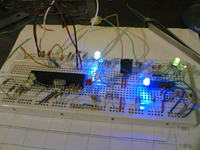kappa_am
Full Member level 6

hi all,
I am examining a program with PIC16F877, outputs are LEDs. It is programmed well, but it does not work well. when I touch it case (not pins just black case near pin1), on each touch it display various results on LEDs and sometimes correct answer. all input pins have pull-down resistor. master clear pin is pulled up by a 10K resistor, and all interrupts are disabled.
I am really confused! what's the problem?!!
I would be grateful if some one help me with this problem.
I am examining a program with PIC16F877, outputs are LEDs. It is programmed well, but it does not work well. when I touch it case (not pins just black case near pin1), on each touch it display various results on LEDs and sometimes correct answer. all input pins have pull-down resistor. master clear pin is pulled up by a 10K resistor, and all interrupts are disabled.
I am really confused! what's the problem?!!
I would be grateful if some one help me with this problem.



